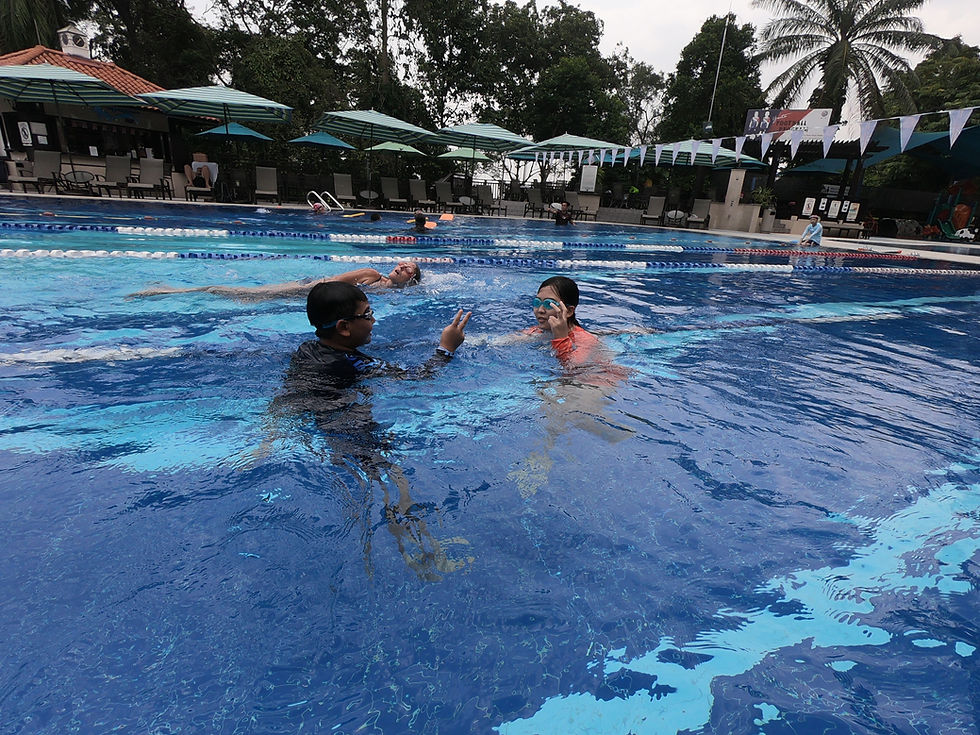How to Teach Swimming to Adults: Tips and Techniques
- SG Sink Or Swim

- Sep 6
- 3 min read

Swimming is a life-saving skill and a lifelong fitness activity, but many adults never had the chance to learn when they were younger. Teaching adults to swim requires a slightly different approach than teaching children — focusing on confidence-building, proper technique, and gradual skill progression. With patience and the right strategies, adult learners can overcome fear, gain water confidence, and develop efficient swimming strokes.
🌊 Why Teaching Adults to Swim Is Unique
Unlike kids, adults often come to lessons with:
Fear or anxiety around water
Preconceptions or bad habits about swimming
Higher motivation due to fitness, safety, or triathlon goals
Less flexibility, making technique adjustments more important
Recognizing these factors helps instructors or self-teaching adults create a program that’s encouraging, structured, and effective.
🏊 Step-by-Step Tips for Teaching Adults to Swim
1. Start with Comfort and Confidence
Begin in shallow water where learners can stand safely.
Practice breathing exercises: exhaling underwater and inhaling above.
Teach floating on the back and front to show that the water can support them.
✅ Building trust in the water comes before learning strokes.
2. Introduce Basic Water Skills
Gliding: Push off gently from the wall and glide with arms extended.
Kicking: Practice flutter kicks with a kickboard for balance.
Submersion practice: Gradually increase comfort with putting the face underwater.
These foundational skills prepare adults for full stroke movements.
3. Teach Proper Breathing Techniques
Breathing is often the most challenging part for adult beginners.
Teach rhythmic breathing — exhaling underwater, inhaling above.
Practice side breathing for freestyle using drills like “side kicking.”
Use short-distance swims to reinforce proper breathing patterns.
4. Progress to Stroke Development
Once comfortable with basics, introduce strokes in a structured way:
Freestyle (Front Crawl): Focus on body rotation, arm pulls, and side breathing.
Backstroke: Helps with relaxation since the face is above water.
Breaststroke: Often easier for adults due to slower rhythm.
✅ Start with one stroke at a time, building confidence before moving on.
5. Use Supportive Equipment
Kickboards for balance
Fins for improving kick strength and body position
Pull buoys for isolating arm strokes
Equipment reduces frustration and helps adults feel supported as they learn.
6. Break Down Skills into Manageable Drills
Adults learn best when complex strokes are broken into small, repeatable drills. For example:
Freestyle arm drills without breathing first
Breaststroke kick practice holding the wall
Backstroke arm movement with a noodle for support
7. Address Fear with Positive Reinforcement
Celebrate every small success, such as floating without panic.
Encourage consistency — short, frequent lessons work better than long, infrequent ones.
Be patient: overcoming fear often takes longer than learning technique.
8. Encourage Practice Outside of Lessons
Confidence grows with repetition. Suggest:
Independent practice sessions in shallow water
Breathing drills in the bathtub or shower
Dryland exercises to improve flexibility and mobility
🧭 Key Teaching Techniques
Demonstrate clearly before asking learners to perform.
Give simple cues (e.g., “blow bubbles,” “kick from hips”).
Adapt pacing to individual comfort levels.
Be encouraging — progress may be slow at first, but every step matters.
🏁 Final Thoughts
Teaching adults to swim is about more than strokes — it’s about building trust, breaking fear, and creating a sense of achievement. With structured lessons, supportive drills, and plenty of encouragement, adults can transition from hesitant beginners to confident swimmers.
Swimming opens the door to fitness, recreation, and safety in the water — and it’s never too late to learn.





Comments